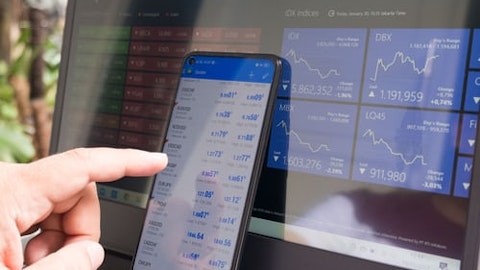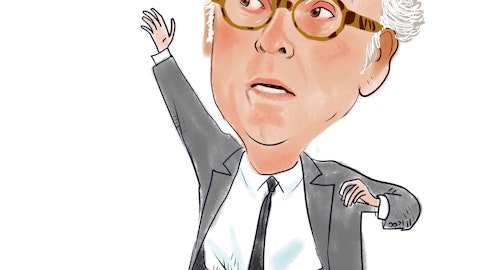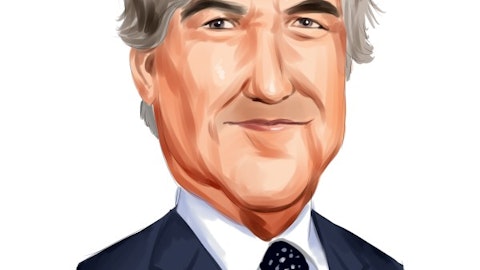Ryan Lynch : Of course. Okay, that’s all for me. I appreciate the time today.
Rick Allorto: Thank you.
Operator: We will go next to Casey Alexander with Compass Point.
Casey Alexander : Yeah, good afternoon. Switch gears just a little bit to a different topic. The company’s position in Cano Health has been handcuffed and that it’s under the control of the private equity sponsor. Have you considered restructuring your equity co-invest or not making equity co-invest, if they fall under the control of the private equity sponsor? Because the company has missed several attractive opportunities to monetize that investment, but the lack of control has all of a sudden resulted in what at this point in time is another poor surprise or a poor outcome. And is there something that you can do to mitigate that loss of control that gives you a better position to take advantage of attractive equity prices when they exist in future investments or not make them at all and get better terms on the debt?
Art Penn : A great question, and there’s a couple discussion points that you brought up, which are really good discussion points. First of all, Cano Health itself, it’s a mark-to-market. Deal is not done yet. They’re the largest competitor. Oak Street Health announced yesterday that they were getting bought by CVS at a very high price. There is a bit of a turf grab going on in that primary care space. So we’re not done yet. I would remind you that Humana is a minority shareholder of Cano Health. Whether they or other parties see value in Cano Health company that the company itself yet to be determined. It has been a volatile stock. It has been painful to watch the stocks trade lower over the course of the last three-six months.
But we’re not done yet on Cano Health and our belief is, over time, this company will ascertain real value above and beyond where it’s being marked today. So that’s Cano Health. Look, part and parcel of the equity coinvestment business, if you want to call it that is, you’re lending money to the company, you’re saying, the sponsor we want to ride alongside of you because we’re helping to drive the growth, and we want to participate in the upside of the growth and we’re also good partners. So in most of the cases, the exits are to strategic buyers or other larger private equity firms. Rarely is the exit to an IPO like Cano was. So in most cases, you can track it and we put it out there. The MOIC on our equity co-invest over 17 years is 2.3 times.
It’s about 27% IRR. And there are times, Casey, when equity looks really good, and there are times when it looks less good. We’re now in one of the times where it looks less good. A year year and half years ago, it looks better. And we’re long-term investors, and we try to think about things in the long term. And understand that once in a while, we’re going to have a quarter where we don’t look that smart, and then there’s been other quarters where we have really smart tenants a public stock we have zero control over where it trades. Most of our equity co-invests are private. And when there’s liquidity, it’s usually to a strategic buyer or another private equity buyer. So we look at it over the 17 years and say being in the equity co-investment business alongside the debt where we’re helping create the upside with the debt.
For us, for 17 years has been good point-to-point and you could pick any point over that 17 years. And of course, there’s going to be quarters where it doesn’t look as smart as it does in other times. So it’s — when you ride alongside the private equity firms, it just kind of is what it is, and they’re the controlled shareholder. We’re not — we become control, unfortunately, sometimes when we have to convert debt to equity and sometimes that works. They really worked well in Pivot. It did not work well in ramp. It did not work well in land. So if it’s in the healthcare space, we have a deep expertise in healthcare. We’ve got a good track record in healthcare. We know what we’re doing in healthcare. Obviously, in the oil and gas, we know what happened there as well, and we’re very disappointed.
Casey Alexander : My next question is relative to the JV. Given the fact that you’re effectively not only fully levered, but somewhat overlevered and likely are going to have to use repayments to reduce your leverage ratio to a certain extent. How does the JV go to $1 billion if you don’t currently have the capability to add additional equity to support that growth?
Art Penn : The JV is financed to some extent with securitization/CLO leverage. The middle market first-lien loans that we do have proven to be really terrific collateral for the CLO securitization box. It’s a strong box. We’ve led through during COVID. It’s really good for middle market credit. There’s lots of elements of middle market credit that make it even more appropriate than wrongly syndicated loan credit. To get to $1 billion, we don’t need to do the degree on the CLO or anticipate doing that, but we do anticipate continuing to use securitization technology to finance the vehicle.
Casey Alexander : So you’re saying that you’re going to add leverage to the JV.
Art Penn : Over time, the leverage will be kind of probably 2 to 1 type of leverage. Again, we own 60% of it —
Casey Alexander : And what’s the leverage in the JV right now?





